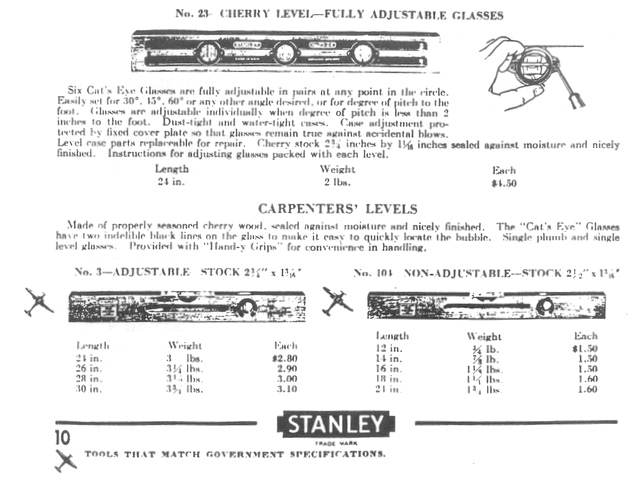
DIFFERENCE BETWEEN THE STANLEY 23 AND 23S LEVELS
By: Don Rosebrook
One of the problems that seem to arise from time to time is identifying the difference between the Stanley 23 and 23S levels. Many people have reported seeing levels identified as Stanley No. 23S offered in flea markets for about $100. I have had levels offered to me through the mail and alleged to be Stanley No. 23S that upon examination proved to be No. 23. I was recently asked if I could give some guidance for specific identification. This article is in response to such a request.
A part of the identification problem is that the level illustrated as a 23S in John Walter's book is. not a 23S but is something resembling a 23. I say something resembling a 23 because the illustration appears to show end caps on the level. There were no such end caps, at least on the early 23 illustrated in a June 1942 catalog that I consulted In addition, the description accompanying the entry in Walter's book claims that there was brass trim on the No. 23S. I have no recognizable brass trim on my 23S. But this shouldn't influence the normal identification of the 23S.
In the first place the Stanley No. 23S is so marked with gold lettering on the Stanley reddish-brown cherry stain used on levels of that era. The Stanley No. 23 is marked as a No. 23 of 23" length and carries the notation "genuine cherry" under the number. The markings are clear and unambiguous. The 23S also carries several other labels that set it apart from the No. 23. One of those copied from my 23S is shown below:
No. 23S - 24"
Red Glass
Declivity Level
These markings are indicative of another difference between the 23 and the 23S. The 23S has one vial with red fluid or one red glass vial in each of the three port holes. Both levels have arrows in the plastic insert inside the port holes but the 23S has one red arrow and one green arrow whereas the 23 has two white arrows.
On the side with the markings described above, the left hand end of the level has a spot marked by a black insert of some sort. There are 2 gold arrows on each side pointing to the black insert. One arrow is horizontal while the other is vertical and each is accompanied by the abbreviation "FWD". I should stress at this point that the levels are similarly constructed. That is that the levels can both be used as declivity levels. Only the 23S, however, is so designated It was accompanied by a removable instruction card (see below). Both levels have independently adjustable vials in each porthole. and the 1942 description of the 23 gives instructions for its use.

The description of the No. 23 from the June 1942. Stanley Catalog No. 50 is reproduced below. Below that are the contents of the instruction card that accompanied the Stanley No. 23S. I am not aware of how long Stanley manufactured the No. 23, but the No. 23S was apparently manufactured only in 1943. It is interesting that as indicated on the instruction card. 1943 was the 100th anniversary of the Stanley Company.
Readers will find further information in "Stanley News" Vol. 2, No.4 page 22. This information infers that the No. 23S was produced for only a small portion of 1943, because the Stanley internal memorandum describing how the engineers thought the level should look was dated in July 1943. The memo describes changes in the existing No. 23 to make a No. 23S.
